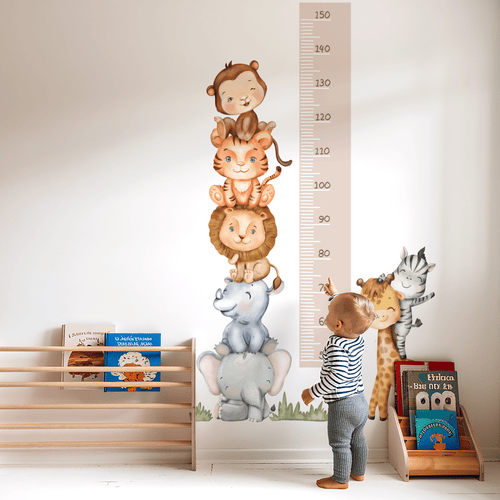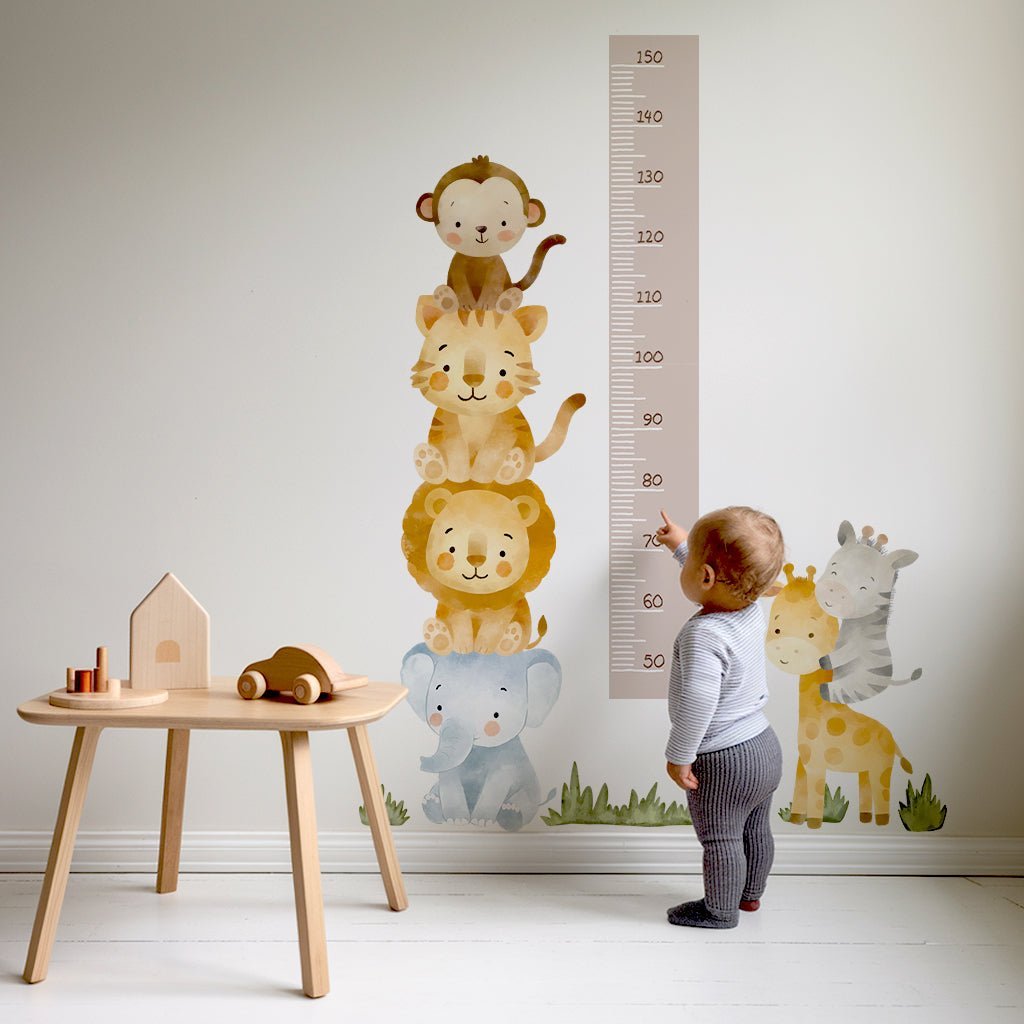In parenting, monitoring a child's growth is of utmost importance. It allows parents and healthcare professionals to track their development and ensure that they are thriving. One tool that has become increasingly popular for this purpose is the height chart. Height charts provide a visual representation of a child's growth over time, offering valuable insights into their overall health and well-being.
Understanding the Importance of Monitoring Children's Growth
Growth is a fundamental aspect of a child's life and is often used as an indicator of their overall health. By monitoring their growth, parents and healthcare professionals can identify any underlying issues or abnormalities at an early stage. Regular monitoring is essential, as it allows for timely intervention in case of any concerns.
Monitoring a child's growth involves tracking various parameters such as height, weight, head circumference, and body mass index (BMI). These measurements provide valuable insights into a child's overall development and nutritional status. For example, a sudden drop in weight or a significant increase in BMI could signal potential health issues that need to be addressed promptly.

The Role of Height Charts in Child Development
Height charts play a significant role in child development. By noting a child's height at different ages, parents can observe patterns and potential growth spurts. This information can be crucial in assessing a child's development and comparing it to average growth rates for their age group. Height charts can help identify delayed growth or early signs of potential health concerns.
It is important to note that growth patterns can vary widely among children, and not all deviations from the norm indicate a health problem. Factors such as genetics, nutrition, and overall health can influence a child's growth trajectory. However, consistent monitoring and communication with healthcare providers can help ensure that any concerns are addressed promptly and appropriately.
Health Implications of Abnormal Growth Patterns
Abnormal growth patterns may indicate underlying health issues that require attention. Height charts can help identify these deviations and prompt parents to seek medical advice. Timely intervention can prevent complications and ensure that the child receives appropriate medical care.
In addition to physical growth, monitoring a child's cognitive and social development is also crucial for their overall well-being. Early detection of developmental delays can lead to timely interventions, such as early intervention services or therapy, which can significantly improve outcomes for the child in the long run.
Different Types of Children's Height Charts
There are several types of children's height charts available, each with its unique features and benefits. Let's explore the most common options:
Wall-Mounted Height Charts
Wall-mounted height charts are a timeless classic. These charts are designed to be hung on a wall, allowing for easy measurement of a child's height. They often have playful designs or colorful illustrations, making them visually appealing and engaging for children.
One advantage of wall-mounted height charts is that they can serve as a decorative element in a child's room. Some charts come with additional stickers or markers that allow children to personalize and mark their growth progress, creating a fun and interactive experience.
Portable Height Charts
Portable height charts provide flexibility and convenience. These charts can be rolled up or folded, making them easy to transport and use in various locations. They are particularly useful for families on the go or for those living in smaller spaces.
Another benefit of portable height charts is that they can be taken along on family vacations or trips, allowing parents to track their child's growth even when away from home. The compact nature of these charts makes them ideal for storing in a suitcase or bag without taking up much space.
Digital Height Charts
With the advancement of technology, digital height charts have emerged as a modern alternative. These charts often come in the form of mobile apps or smart devices that record and track a child's height electronically. They offer additional features such as personalized growth insights, reminders, and the ability to share data with healthcare professionals.
Some digital height charts also come with interactive games or educational content to engage children in the tracking process. This can make height measurement more enjoyable for kids and encourage them to participate in monitoring their own growth. Additionally, digital charts can provide detailed graphs and charts showing growth trends over time, giving parents a comprehensive view of their child's development.
How to Use a Children's Height Chart
Using a children's height chart correctly is crucial to ensure accurate measurements. Here are some essential tips:
Correct Positioning for Accurate Measurements
When measuring a child's height, it is important to position them correctly. Ensure that their back is straight, their feet are flat on the ground, and their heels are touching the base of the height chart. Take the measurement at eye level to minimize errors.
It's also beneficial to have the child remove any bulky clothing or shoes that could affect the accuracy of the measurement. Additionally, make sure the child is standing up straight without slouching to get the most precise reading.
Interpreting the Results
Interpreting the results of a height measurement involves comparing them to established growth norms. This can be done by referring to growth charts provided by healthcare professionals or reputable sources. Understanding the percentiles and trends can help identify any potential areas of concern.
Keep in mind that children grow at different rates, and growth spurts are common during certain stages of development. It's essential to track the child's growth over time to monitor their overall health and development accurately. If there are any significant deviations from the expected growth pattern, consulting a healthcare provider is recommended to address any potential issues promptly.

Age-Specific Height Chart Considerations
As children develop at different rates, it is essential to consider age-specific factors when using height charts. Understanding the nuances of growth and development can provide valuable insights into a child's overall well-being.
When utilizing height charts, it is crucial to remember that they serve as a tool for monitoring growth trends rather than as a definitive measure of a child's health. By taking into account age-specific considerations, caregivers and healthcare providers can better assess a child's growth trajectory and address any potential concerns proactively.
Height Charts for Infants
For infants, height measurements can be challenging due to their inability to stand straight independently. In such cases, recumbent length measurements may be taken while the child is lying down. Comparing these measurements with age-specific norms helps determine if the infant is growing appropriately. It is important to note that during the first year of life, infants typically experience rapid growth, and variations in growth rates are common. Regular monitoring and consultation with healthcare professionals can help ensure that any deviations from the norm are addressed promptly.
Height Charts for Toddlers
For toddlers, the primary focus should be on tracking their growth patterns rather than fixating on absolute height measurements. As toddlers experience growth spurts and changes in body proportions, height measurements should be interpreted within the context of overall development. It is also essential to consider factors such as nutrition, physical activity, and genetics when assessing a toddler's growth. By maintaining a holistic view of growth and development, caregivers can support optimal health and well-being in toddlers.
Height Charts for School-Aged Children
Height charts become more valuable as children enter school age. Regular measurements can help identify any growth abnormalities or variations from typical growth patterns. This information can be shared with healthcare professionals to ensure the child's well-being. Additionally, as children grow older, their height can be influenced by factors such as puberty and hormonal changes. Monitoring height trends over time can provide valuable information about a child's overall growth and development.
Frequently Asked Questions About Children's Height Charts
When Should I Start Using a Height Chart?
It is recommended to start using a height chart from infancy. Tracking a child's growth from the beginning provides a comprehensive understanding of their developmental trajectory.
Starting with a height chart early on allows parents to establish a baseline for their child's growth patterns. This baseline can help in detecting any deviations from the expected growth trajectory and prompt timely intervention if needed. Additionally, having a record of a child's height progression from infancy can be a cherished keepsake for both parents and children to look back on in the future.
How Often Should I Measure My Child's Height?
The frequency of height measurements depends on the child's age and any specific concerns identified. In general, measuring a child's height annually is a good practice. However, if there are any growth-related concerns, more frequent measurements may be required.
Regular height measurements not only track a child's physical growth but also provide valuable information about their overall health and well-being. By consistently monitoring height changes, parents can spot trends, address any potential issues early on, and ensure that their child is growing at a healthy rate. Remember, growth is just one aspect of a child's development, and combining height measurements with other assessments can offer a more holistic view of their progress.
Children's height charts are instrumental in monitoring growth, identifying potential issues, and providing insights into a child's health and development. By using a height chart appropriately and understanding the results, parents can take an active role in ensuring their child's well-being. Remember, every child is unique, and while growth milestones provide guidance, they shouldn't overshadow each child's individual journey.





















